


A solid chromium peroxo pyridine complex
When dichromate in acidic solution is mixed with hydrogen peroxide, then a dark blue complex is formed, which is sometimes written as CrO5. This reaction is very sensitive and it sometimes is used as a qualitative test for water-soluble hexavalent chromium. The true formula of this complex is CrO(O2)2. This complex is very unstable in water and it quickly decomposes, giving oxygen and trivalent chromium. In the presence of pyridine, a much more stable complex is formed. This complex is insoluble in water. It is very hard to isolate though, it forms a thick foam, which cannot be filtered. This foam slowly decomposes, giving oxygen gas, and for this reason it remains floating on the liquid and the solid does not settle at the bottom. The decomposition product of this complex appears to be CrO3 with a small amount of trivalent chromium as well. It slowly dissolves in water, making the solution orange with a brown tinge.
![]()
![]() Required
chemicals:
Required
chemicals:
-
sodium dichromate (the potassium salt also is suitable)
-
hydrogen peroxide (10% solution)
-
sodium sulfite
-
sulphuric acid
-
pyridine
![]() Required
equipment:
Required
equipment:
-
erlenmeyer
-
test tubes
-
glass rod
![]() Safety:
Safety:
- Dichromates are toxic and there is strong evidence that hexavalent chromium is a carcinogen. Be sure not to be exposed to this.
- Concentrated sulphuric acid is very corrosive. Avoid contact with the skin. If there is accidental contact, then immediately wipe off the acid with a dry tissue and rinse with plenty of cold water.
- Hydrogen peroxide in concentrations of more than 6% are highly irritating and give rise to white spots, which are stinging.
- Pyridine is toxic and has a terrible smell. Avoid inhaling too much of the vapor.
![]() Disposal:
Disposal:
- Reduce all of the material with sodium sulfite and some excess sulphuric acid or hydrochloric acid. After reduction, keep the waste as heavy metal waste and bring this to a proper waste processing facility.
![]()
Formation of the dark blue/purple complex
![]() Take
approximately 1 ml of pyridine and 1 ml of concentrated sulphuric acid. Add both
chemicals to approximately 40 ml of cold water and swirl such that all liquids
have mixed. After the mixing, the smell of pyridine hardly can be observed
anymore. It is loosely bound by the sulphuric acid, forming the labile
pyridinium ion.
Take
approximately 1 ml of pyridine and 1 ml of concentrated sulphuric acid. Add both
chemicals to approximately 40 ml of cold water and swirl such that all liquids
have mixed. After the mixing, the smell of pyridine hardly can be observed
anymore. It is loosely bound by the sulphuric acid, forming the labile
pyridinium ion.
![]() Take a spatula full of sodium dichromate (a few 100's of mg)
and dissolve this in 10 ml of water.
Take a spatula full of sodium dichromate (a few 100's of mg)
and dissolve this in 10 ml of water.
![]() Mix the two solutions. The resulting solution is a clear
orange solution, which contains a labile CrO3-pyridine complex with
excess pyridine and sulphuric acid.
Mix the two solutions. The resulting solution is a clear
orange solution, which contains a labile CrO3-pyridine complex with
excess pyridine and sulphuric acid.
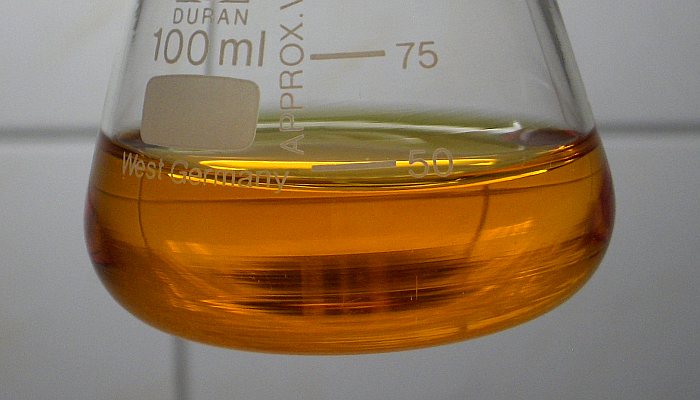
![]() Let the orange liquid cool down in a fridge (no freezing is
needed, a temperature of approximately 10 �C is suitable).
Let the orange liquid cool down in a fridge (no freezing is
needed, a temperature of approximately 10 �C is suitable).
![]() To the orange solution slowly add a few ml of cool 10%
hydrogen peroxide and swirl the solution while the hydrogen peroxide is added.
When this is done, then the liquid first becomes very dark, almost black. Then
it starts foaming. The foam is remarkably stable. It did not rise over the rim
of the erlenmeyer, but no guarantee can be given that this does not happen when
the experiment is repeated. Be sure to perform this experiment in a place,
where accidental spilling of the dark foam does no harm. The erlenmeyer with
liquid and foam looks as follows after adding the hydrogen peroxide.
To the orange solution slowly add a few ml of cool 10%
hydrogen peroxide and swirl the solution while the hydrogen peroxide is added.
When this is done, then the liquid first becomes very dark, almost black. Then
it starts foaming. The foam is remarkably stable. It did not rise over the rim
of the erlenmeyer, but no guarantee can be given that this does not happen when
the experiment is repeated. Be sure to perform this experiment in a place,
where accidental spilling of the dark foam does no harm. The erlenmeyer with
liquid and foam looks as follows after adding the hydrogen peroxide.
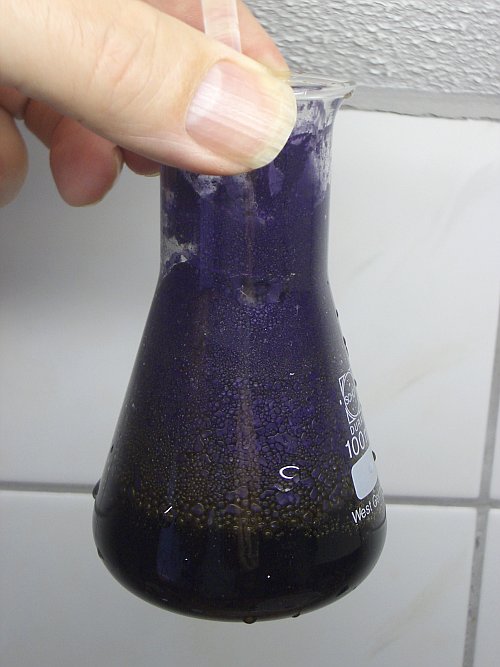
It also is wise to cover the erlenmeyer with a paper tissue, immediately after adding the hydrogen peroxide. Very small droplets of liquid with the hexavalent chromium may be released in the air, due to the bubbling of the liquid.
![]()
Properties of the dark blue compound
The blue material is not an easily separated solid, but it forms the basis of a stable foam, which unfortunately cannot be filtered.
With a glass rod, one can take quite a lot of foam from the erlenmeyer. It sticks to the rod and remains stable.
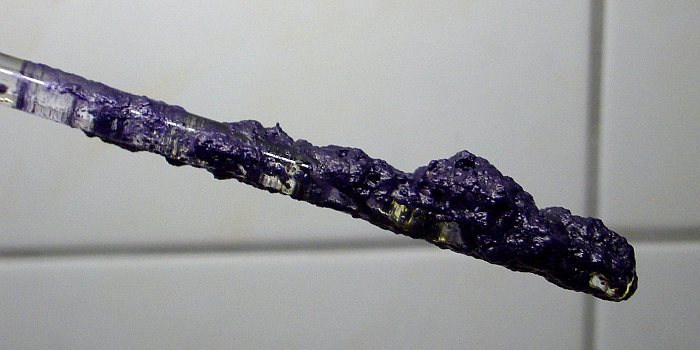
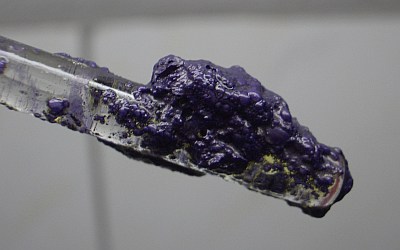 When
the glass rod with dark blue foam is put in a test tube with some water, then a
brown solution is obtained with blue/purple foam above it. The picture at the
left shows the glass rod (which has a diameter of 5 mm) with some foam near the
tip.
When
the glass rod with dark blue foam is put in a test tube with some water, then a
brown solution is obtained with blue/purple foam above it. The picture at the
left shows the glass rod (which has a diameter of 5 mm) with some foam near the
tip.
This amount of foam was put in a test tube and water was rinsed along the glass rod in order to get all of the foam in the test tube. The pictures below show the result of rinsing the foam into the test tube. Above the water, there is a layer of foam, which is almost black. In the water, many small particles are floating around. These particles slowly move upwards, while they dissolve, but at the same time decompose (giving oxygen bubbles, which cause them to move upwards). The foam slowly collapses. The right picture shows the same test tube, somewhat later.
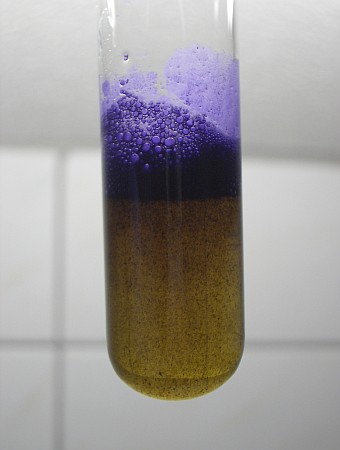
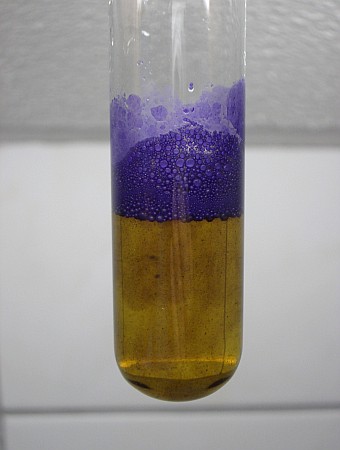
The brown solution contains free dichromate/chromic acid, but it almost certainly also contains some chromium(III), otherwise the color would be bright orange and not brown. When a large excess of sodium sulfite is added, then the liquid becomes totally clear within a few tens of seconds and the color shifts from brown to yellow with a green tinge. The color of the liquid is in nice contrast with the color of the foam, it looks very special, as shown by the picture below.
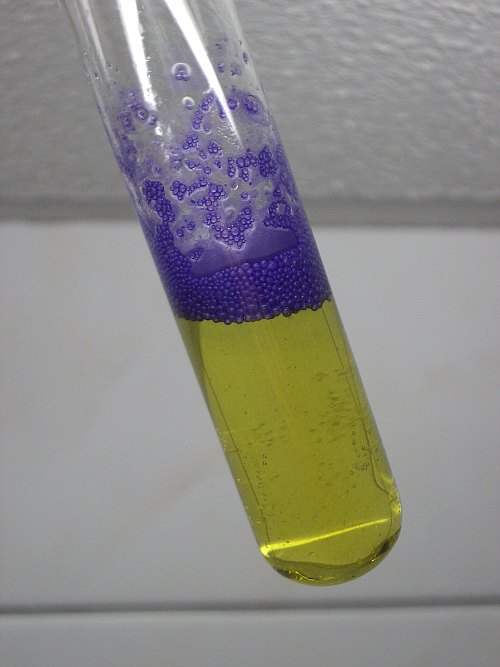
The shift of color from brown to yellow/green most likely is due to change of pH. The alkaline sulfite makes any dichromate/chromic acid appear yellow, due to formation of chromate. Any small amount of chromium(III) gives a green hue to the color of the solution. Hexavalent chromium is not quickly reduced by sulfite. Only in the presence of excess acid, this reaction proceeds at high speed. As soon as some acid is added (e.g. some 20% sulphuric acid), then the color at once shifts from yellow to green/blue, with many small dark blue/purple particles in the liquid.
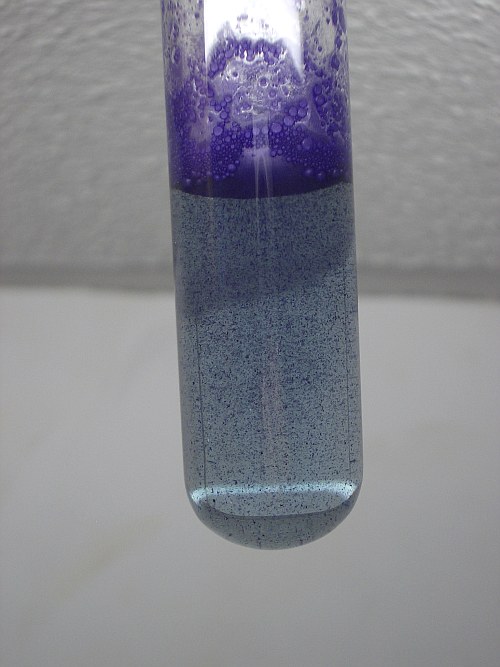
The foam does not dissolve at once, even when there is a strong smell of SO2 (implying large excess of sulfite and large excess of acid), then the foam does not dissolve quickly. Only after a few minutes, all of the foam has dissolved and also all particles have dissolved, leaving a clear grey/green/blue solution, which only contains chromium(III) in solution.
The picture below shows the test tube, approximately 2 minutes after adding the acid. Most of the particles already dissolved, and most of the foam also has dissolved, only some larger bubbles are left behind.
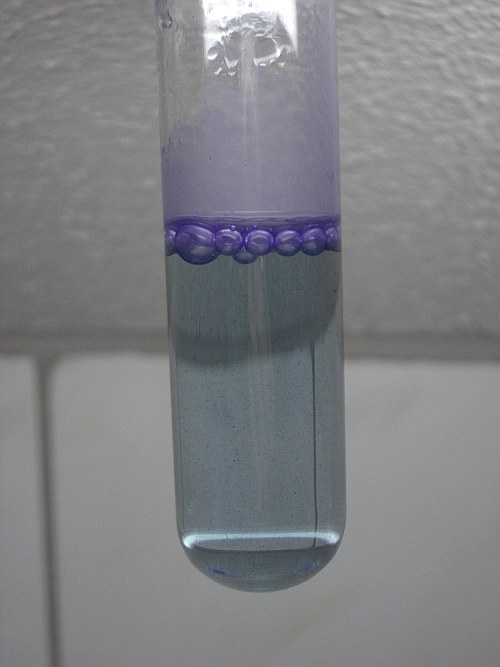
![]()
Discussion of the results
![]() In the
presence of acid and pyridine, hexavalent chromium forms a labile complex with
pyridine:
In the
presence of acid and pyridine, hexavalent chromium forms a labile complex with
pyridine:
Cr2O72- + 2H+ + 2C5H5N ↔ 2C5H5N:CrO3 + H2O
The above reaction equation is highly simplified, in reality, pyridine also complexes with acid, giving pyridinium ions (similar to ammonia, which gives ammonium ions, except that the pyridinium ions are much more labile).
![]() When
hydrogen peroxide is added, then ligand exchange occurs, with exchange of two
oxo-ligands by peroxo ligands. A new complex is formed, which is not as labile
as the pyridine-CrO3 complex.
When
hydrogen peroxide is added, then ligand exchange occurs, with exchange of two
oxo-ligands by peroxo ligands. A new complex is formed, which is not as labile
as the pyridine-CrO3 complex.
C5H5N:CrO3 + 2H2O2 → C5H5N:CrO(O2)2 + 2H2O
This complex is much more stable and the pyridine is firmly attached to the chromium atom now. This complex is insoluble in water, and hence it precipitates.
The pyridine-chromium bond is quite strong in this complex, but the peroxo ligands tend to decompose, giving rise to formation of oxygen (hence the foaming) and the decomposition also gives the labile pyridine-CrO3 complex again. This complex dissolves again, giving rise to orange dichromate in solution. The color is not purely orange. Some of the chromium(VI) also is reduced by the hydrogen peroxide, or internal reduction in the CrO(O2)2 complex occurs, with formation of chromium(III). The mix of dichromate/chromic acid, and the chromium(III) compound gives the color is dirty brown appearance.
![]() When
excess sodium sulfite is added to the solution, then the liquid becomes
alkaline, and the dichromate changes to chromate. This is yellow. Any
chromium(III) remains in solution as a chromite-species, which is green. The
resulting liquid hence looks yellow with a green tinge. It is remarkable to see
how stable the foam and blue compound are in the alkaline solution with excess
sulfite. This most likely is because of the very low solubility of the
pyridine-CrO(O2)2
complex.
When
excess sodium sulfite is added to the solution, then the liquid becomes
alkaline, and the dichromate changes to chromate. This is yellow. Any
chromium(III) remains in solution as a chromite-species, which is green. The
resulting liquid hence looks yellow with a green tinge. It is remarkable to see
how stable the foam and blue compound are in the alkaline solution with excess
sulfite. This most likely is because of the very low solubility of the
pyridine-CrO(O2)2
complex.
![]() When
acid is added, then the chromate is converted to dichromate, which at once is
reduced by the sulfite (which now is present as SO2). The liquid
contains chromium(III) which gives it a green/blue color. The pyridine-CrO(O2)2
complex still does not dissolve at once, but in this reducing and acidic
environment it does dissolve much faster than in any of the other situations, as
described above.
When
acid is added, then the chromate is converted to dichromate, which at once is
reduced by the sulfite (which now is present as SO2). The liquid
contains chromium(III) which gives it a green/blue color. The pyridine-CrO(O2)2
complex still does not dissolve at once, but in this reducing and acidic
environment it does dissolve much faster than in any of the other situations, as
described above.